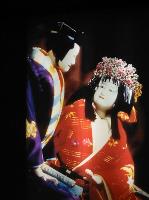Traditional Bunraku puppetry
 Male and female Bunraku puppets
Male and female Bunraku puppets
The origins of Bunraku puppetry
Bunraku puppetry began in Osaka, Japan, in 1684. It merges the two traditional forms of storytelling and puppetry performed by travelling storytellers and puppeteers and was established as a performance genre when the narrator, Takemoto Gidayu, set up a puppet theatre in Osaka.
Bunraku reached its height of popularity in around 1744, when it experienced a golden age. The plays often focused on historical stories from feudal times. The stories were about love affairs, social duties and the moralities of loyalty.
Most plays were written by the famous playwright Chikamatsu Monzaemon (1653–1725) who wrote approximately 140 plays. He also wrote for the Kabuki theatre and is often called the Japanese Shakespeare.
Bunraku puppetry performance
Pronounced boon-rah-koo, the puppets are also known as ningyo joruri in Japanese. They are life-size, beautifully hand-carved wooden rod puppets with elaborate costumes and individualised facial expressions. Visible puppeteers manipulate them to present dramatic plays.
A traditional performance includes puppets, puppeteers, the tayu or narrator who tells the story and the shamisen musician, who accompanies the narrator. The shamisen is a three-stringed musical instrument played with a plectrum or pick.
Three puppeteers control different parts of the body for each puppet. They are dressed in black and carefully coordinate the exact movement of each body part of the puppet.
The three puppeteers are:
- Omo-zukai – the head puppeteer, who operates the doll's head and face by holding a stick with levers in his left hand, also operates the doll's right hand with his own right hand
- Hidari-zukai – the left-hand puppeteer, who uses his right hand to operate the doll's left hand
- Ashi-zukai – the foot puppeteer, who uses both hands to suggest the movements of the doll's legs and feet.
The puppeteers merge with the puppet in order to control it and move as a team to the sounds of the narrator and musician.
To train as a Bunraku puppeteer takes many years. Puppeteers start their training with simple puppets, advancing to more complex ones as they become more experienced.
Bunraku today
During the 20th century, Bunraku's popularity waned for many decades but began to be revived with the establishment of the National Bunraku Theatre in 1966. The use of life-size puppets, the placement of the puppeteer in full view of the audience, and the visible manipulation of the puppet by puppeteers are all key elements included in theatre today.
Bunraku performance in Australia
In 1972, Australia experienced its first Bunraku performance when the National Theatre of Japan performed at the Adelaide Festival of the Arts. Many companies over the years have included aspects of Bunraku theatre style in Australia. For example, the Australian puppet theatre company Dead Puppet Society uses many of the above conventions in its productions.
Their website has images of the life-size puppets they used in The Harbinger with the puppeteers manipulating the puppets from the sides. Australian theatre director Peter Wilson has also included life-size puppets in productions for children such as The red tree and The flying orchestra, at the Out of the Box Festival in Queensland's Performing Arts Centre.